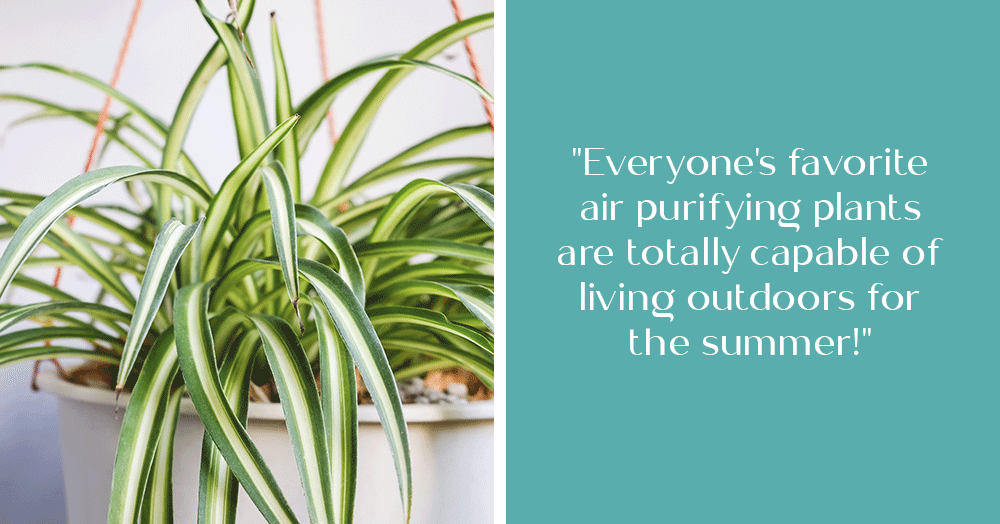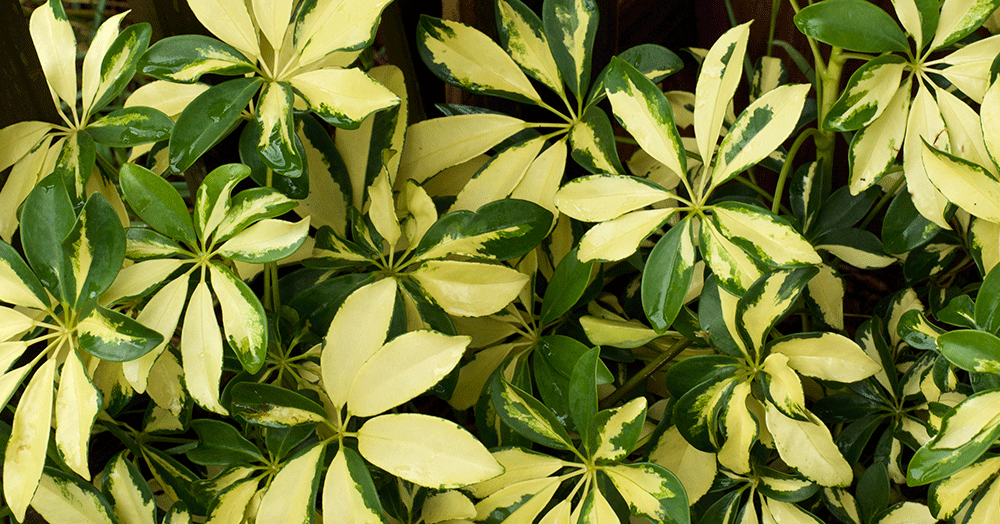If you want your outdoor patio all decked out for summer (pun intended), you don’t have to rely exclusively on short-lived annual plants for bringing color to the scenery. A lot of your favorite houseplants can be brought outside the house for summer. Just like us, they appreciate a little extra fresh air and sunshine in summer, and time out in nature can be more comfortable than sitting in a hot, stuffy corner of the house.
Before you start bringing all your houseplants outside for the summer season, it’s important to think critically about each plant’s individual needs. Suddenly going from indirect window light to direct summer sun could scorch the leaves of even the toughest cacti. Plants that like direct sun can eventually be placed in a sunny spot, but some houseplants—particularly tropicals—prefer indirect light, so they’re better off staying in a shadier spot like underneath a tree canopy.

When you’re transitioning houseplants outside for the summer, it’s a good idea to make the transition gradual, starting with just a few hours outdoors in a shaded area. Leave them outside for a couple of hours longer each day, and bring sun-loving plants gradually into direct light. After about a week, they should be okay to leave outside for the rest of the season.
These Houseplants Can Spend Their Summers Outside
Some houseplants, like fiddle leaf figs and monsteras, can be particularly sensitive to changes in their environment, so it might not be worth the effort trying to bring them outside. However, there are still many houseplants that will gladly bask outside in the summer sun, so you can enjoy a colorful patio without having to splurge on a bunch of new plants.
Potted palms
These pet-friendly plants are super low-maintenance, so they’re always a good choice for beginners. Their breezy, tropical vibe is perfect for adding some fun summer flair to your patio and garden decor. If you’ve got smaller potted palms, like the areca or parlor palm, and you’d like them to grow to the size of a small tree, bringing them outdoors will help speed things along. Remember to fertilize and water regularly to keep them adequately fueled!
Crotton
An exuberant houseplant that rarely goes unnoticed, the croton features splashes of neon red, orange, green, and gold. Bringing this houseplant outside onto the patio will help boost along its summer growth spurt, so be sure to fertilize it consistently from spring until early fall so it’s properly fueled. A croton that’s well taken care of can live for several decades and grow to the size of a small tree, and the bright summer sun will help keep its colorful leaves looking extra vibrant!
Dieffenbachia
The dieffenbachia, or dumb cane, is one of the toughest plants around, so bringing it outside is pretty easy. Partial shade is the best spot for a dieffenbachia, so if there’s an area of your patio that gets sun in the morning but is shaded for the afternoon, your plant will be very happy there! It can handle full shade without throwing a fit, it just won’t grow quite as quickly. Be sure to bring it back inside before the temperature dips below 60°F.
Succulents and cacti
Our favorite desert-dwelling plants are especially keen on soaking up the summer sun. The increase in sun often results in some pretty impressive blooms, so succulents and cacti are perfect for bringing color into your patio and garden decor. Play around with mixed succulent and cacti arrangements to use as centerpieces for outdoor dining tables and patio sets. If you place them in direct sun, be prepared to water them nearly every day, as the heat will evaporate the moisture in their small pots much quicker.

Spider Plant
Everyone’s favorite air purifying plants are totally capable of living outdoors for the summer! These green beauties will have a significant growth spurt outside the house, which often results in plenty of baby plants sprouting from their long, green stems. You can pluck those bad boys off, plant them in their own little pots of soil, and fill your patio with tons of lush greenery!
Ruber Plants
This especially hardy breed of ficus can really benefit from time outdoors during the summer. While other ficus varieties can be a bit finicky to shifts in light levels (yeah, we’re looking at you, fiddle leaf fig), this plant will thrive outside the house with little worry. If your rubber plant is showing signs of being rootbound, it’s worth repotting it into a slightly larger container at the start of the season to accommodate all its new growth.
Schefflera
While indoor-grown Schefflera trees develop more slowly, if you bring your Schefflera outside the house in summer, you’re bound to see a major increase in height! It may even sprout some colorful blossoms, which it isn’t as likely to do when it remains indoors. Make sure it isn’t rootbound and has space to spread out in its container. It does best in bright, indirect light, so place it under a tree canopy or somewhere that’s sunny in the morning and shady in the afternoon.
Bringing Outdoor Plants Indoors
Moving houseplants outside is a bit different from bringing them back inside at the end of summer. There are far more insect species and pests lurking around outside the house, and if you aren’t careful, you could end up introducing some destructive plant pests to all your other indoor plants.
Debugging your plants with a natural insecticide like neem oil or soap spray will help kill off any hiding insects. Keep those plants at a safe distance from your other indoor plants for a couple of weeks to reduce the risk of any pests hopping off one plant and setting up camp in another. Inspect your plants a few days after applying insecticide, and apply one or two follow-up treatments to be sure there are no lingering bugs, eggs, or larvae.








